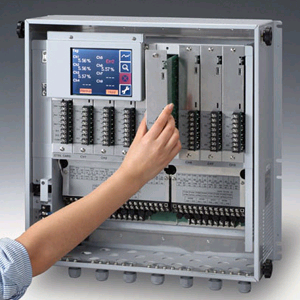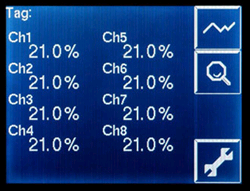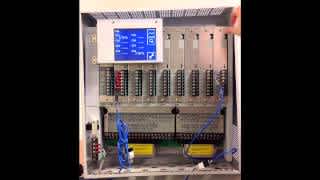The Multi-Channel Zirconia Oxygen Analyzer System delivers accurate O2 measurements utilizing Yokogawa’s zirconia oxygen analyzers for combustion monitoring and control, helping industries achieve lowered CO2, SOX, and NOX emissions. The oxygen analyzer system provides minimized downtime and simplified maintenance with advanced diagnostics, intuitive design and technician training, in addition to having the ability to connect up to eight probes to one analyzer.
System
The Multi-Channel Zirconia Oxygen Analyzer System includes the AV550G converter and ZR22 detector and is capable of measuring oxygen concentrations. The system includes all of the features of the single-channel system as well as additional functions such as averaging outputs and accessibility of all probes in one analyzer.
ZR22G/ZR22S Detector
The ZR22G separate-type detector is an in-situ probe that uses a high-reliability zirconia sensor. The zirconia cell and heater assembly can be replaced in the field, reducing maintenance costs. The ZR22S separate-type detector for explosion-proof applications is also available and offers the following explosion-proof certifications:
- ATEX
- FM
- CSA
AV550G Multi-Channel Zirconia Oxygen Analyzer
The AV550G averaging oxygen analyzer is ideal for combustion control in large utility boilers and industrial furnaces and features a 5.7-inch color LCD touch screen, “hot-swappable” channel cards to minimize downtime and up to eight probe inputs. The AV550G can output the average oxygen concentration from a user-selected group of zirconia detectors, and detectors that are in alarm, calibration, or that are not in service, are automatically removed from the average output. This is especially useful when performing calibration or maintenance.


Features
 Accurate Maintenance Scheduling with Advanced Diagnostics
Accurate Maintenance Scheduling with Advanced Diagnostics
Predictive diagnostics from the analyzer simplify troubleshooting and provide technicians with the necessary data to create a minimal calibration schedule with the help of the smart calibration, asymmetry alarm, and trend graphing functions.
- Smart calibration: uses historical calibration data to estimate when to perform the next calibration.
- Asymmetry alarm uses historical calibration data to determine possible measurement errors due to process condition changes.
- Trend graphing: provides trend views and stacked trend views of oxygen concentrations.
Reduced Downtime with a Robust Cell Design
The probe's cell is designed with a large measurement surface area, making it less susceptible to contaminants, which allows for longer periods between cell replacements and calibrations.


Increased Measurement Availability with an Intuitive Design
The probe uses a long-life, high-reliability zirconia sensor and has an intuitive design that enables easy troubleshooting and repair in the field, minimizing downtime and reducing costs since technicians only need to replace the needed parts.
Increased Process Uptime with Customized Training Resources
Yokogawa’s knowledgeable representatives and support technicians provide operation and repair training for all Yokogawa products both in the factory and in the field. Training ranges from basic operation to advanced troubleshooting, helping you achieve more efficient operations and simplified maintenance.
Details
-
WZ-H Cables
- WZ-H cables
- Compatible with ZR22, ZR402, and AV550G Oxygen Analyzer Systems
- Transmit sensor/detector signal to analyzer
- Electrical input for cell temperature control
-
FLY ASH Filter
The accumulation of fly ash on the zirconia cell affects its ability to measure oxygen concentration. Fly ash and its constituents can reduce the life of the zirconia cell and affect the cells response time to changes in gas concentration. Yokogawa's large surface area sintered metal filters are designed to keep particulate and ash off the measurement cell.
-
Calibration Units
Yokogawa's Zirconia oxygen detector systems offer a variety of calibration units for quick, easy control of calibration gases giving the user simple, accurate calibration.
Resources
In a hot blast stove, the by-product gas produced in a coke oven is burned to preheat the air blast for the blast furnace. To improve the combustion efficiency and conserve energy in a hot blast stove, it is essential to be able to control combustion by measuring and adjusting the oxygen concentration in the exhaust gases.
Tantalum Capacitors are electrolytic capacitors that use a material called tantalum for the electrodes. Large values of capacitance similar to aluminum electrolytic capacitors can be obtained.
Downloads
Brochures
- Model EXAxt AV550G Averaging Oxygen Analyzer (3.5 MB)
- Product Poster (751 KB)
Instruction Manuals
- AC4/AC8 - For Use With AV550G (1.8 MB)
- AV550G Zirconia Oxygen Analyzer Averaging Converter (13.1 MB)
- Model ZR22P High Temperature Adapter (1.6 MB)
- EXAxt AV550G HART Protocol (2.2 MB)
- AV550G Fieldbus Communication (559 KB)
- AV550G, ZR402G, ZR22G, ZR22S, ZR202G, ZR202S, ZA8F, ZR20H, ZR40H, ZO21P, ZO21R, ZH21B Protection of Environment (Use in China) (185 KB)
General Specifications
Technical Information
- Analytical Oxygen Product Selection Guide (759.2 KB)
- Quick Zirconia Probe Diagnostics (585 KB)
- Quick Zirconia Probe Diagnostics (584 KB)
- Filter for Oxygen Probes (694.3 KB)
- Oxygen Probe Troubleshooting Guide (209.4 KB)
- ZR22P - High Temperature Probe Adapters
Certificates
- C-Tick: Australian Government (30 KB)
- C-Tick: Australian Government (30 KB)
- CE (44 KB)
- CE (44 KB)
- CSA (139 KB)
- CSA (93 KB)
- KC (110 KB)
- KC (111 KB)
Engineering Tools
- 4-Channel Wiring for Autocal and Remote Validation (752 KB)
- Averaging Converter AV550G (61 KB)
- 4-Channel Wiring for Autocal, ZR22 & ZO21D probes (471 KB)
- 4-Channel Wiring for IAC24 (321 KB)
- 8 Channel Converter with Split Auto Calibration (584 KB)
- 8-Channel Wiring for Autocal, ZR22 & ZO21D Probes (544 KB)
- Dual AV550s with AC8 Auto Calibration (616 KB)
Forms
- Oxygen Application Data Sheet (35 KB)
Videos
How to change a channel card on an AV550G without disturbing the other seven channels.
Replacing a ZR22A heater strut on a ZR22G zirconia oxygen probe. While we strive to provide the most safe and accurate information possible, we are not responsible for any loss or damages resulting from attempting to replicate the acts conducted in this video. Furthermore, we shall not be held liable for use or misuse of information contained in this video.
Looking for more information on our people, technology and solutions?
Contact Us



